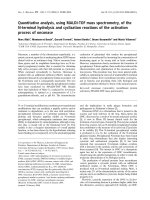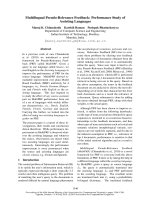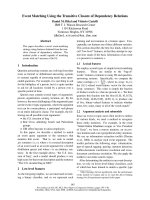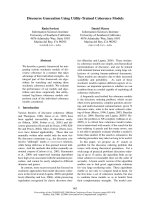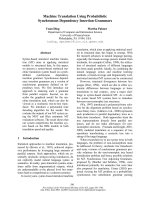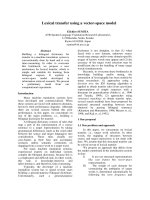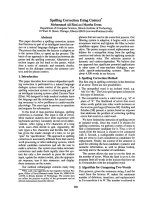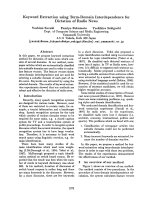Báo cáo khoa học: "Multilingual Transliteration Using Feature based Phonetic Method" docx
Bạn đang xem bản rút gọn của tài liệu. Xem và tải ngay bản đầy đủ của tài liệu tại đây (265.65 KB, 8 trang )
Proceedings of the 45th Annual Meeting of the Association of Computational Linguistics, pages 112–119,
Prague, Czech Republic, June 2007.
c
2007 Association for Computational Linguistics
Multilingual Transliteration Using Feature based Phonetic Method
Su-Youn Yoon, Kyoung-Young Kim and Richard Sproat
University of Illinois at Urbana-Champaign
{syoon9,kkim36,rws}@uiuc.edu
Abstract
In this paper we investigate named entity
transliteration based on a phonetic scoring
method. The phonetic method is computed
using phonetic features and carefully
designed pseudo features. The proposed
method is tested with four languages –
Arabic, Chinese, Hindi and Korean – and
one source language – English, using
comparable corpora. The proposed method
is developed from the phonetic method
originally proposed in Tao et al. (2006). In
contrast to the phonetic method in Tao et al.
(2006) constructed on the basis of pure
linguistic knowledge, the method in this
study is trained using the Winnow machine
learning algorithm. There is salient
improvement in Hindi and Arabic
compared to the previous study. Moreover,
we demonstrate that the method can also
achieve comparable results, when it is
trained on language data different from the
target language. The method can be applied
both with minimal data, and without target
language data for various languages.
1 Introduction.
In this paper, we develop a multi-lingual
transliteration system for named entities. Named
entity transliteration is the process of producing,
for a name in a source language, a set of one or
more transliteration candidates in a target language.
The correct transliteration of named entities is
crucial, since they are frequent and important key
words in information retrieval. In addition,
requests in retrieving relevant documents in
multiple languages require the development of the
multi-lingual system.
The system is constructed using paired
comparable texts. The comparable texts are about
the same or related topics, but are not, in general,
translations of each other. Using this data, the
transliteration method aims to find transliteration
correspondences in the paired languages. For
example, if there were an English and Arabic
newspaper on the same day, each of the
newspapers would contain articles about the same
important international events. From these
comparable articles across the paired languages,
the same named entities are expected to be found.
Thus, from the named entities in an English
newspaper, the method would find transliteration
correspondences in comparable texts in other
languages.
The multi-lingual transliteration system entails
solving several problems which are very
challenging. First, it should show stable
performance for many unrelated languages. The
transliteration will be influenced by the difference
in the phonological systems of the language pairs,
and the process of transliteration differs according
to the languages involved. For example, in Arabic
texts, short vowels are rarely written while long
vowels are written. When transliterating English
names, the vowels are disappeared or written as
long vowels. For example London is transliterated
as lndn نﺪﻨﻟ, and both vowels are not represented
in the transliteration. However, Washington is
often transliterated as
wSnjTwn
نوطﻧــــــــــــﺷاو
, and
the final vowel is realized with long vowel.
Transliterations in Chinese are very different from
the original English pronunciation due to the
112
limited syllable structure and phoneme inventory
of Chinese. For example, Chinese does not allow
consonant clusters or coda consonants except [n,N],
and this results in deletion, substitution of
consonants or insertion of vowels. Thus while a
syllable initial /d/ may surface as in Baghdad
巴格达 ba-ge-da, note that the syllable final /d/ is
not represented. Multi-lingual transliteration
system should solve these language dependent
characteristics.
One of the most important concerns in a
multilingual transliteration system is its
applicability given a small amount of training data,
or even no training data: for arbitrary language
pairs, one cannot in general assume resources such
as name dictionaries. Indeed, for some rarely
spoken languages, it is practically impossible to
find enough training data. Therefore, the proposed
method aims to obtain comparable performance
with little training data.
2 Previous Work
Previous work — e.g. (Knight and Graehl, 1998;
Meng et al., 2001; Al-Onaizan and Knight, 2002;
Gao et al., 2004) — has mostly assumed that one
has a training lexicon of transliteration pairs, from
which one can learn a model, often a source-
channel or MaxEnt-based model.
Comparable corpora have been studied
extensively in the literature, but transliteration in
the context of comparable corpora has not been
well addressed. In our work, we adopt the method
proposed in (Tao et al., 2006) and apply it to the
problem of transliteration.
Measuring phonetic similarity between words
has been studied for a long time. In many studies,
two strings are aligned using a string alignment
algorithm, and an edit distance (the sum of the cost
for each edit operation), is used as the phonetic
distance between them. The resulting distance
depends on the costs of the edit operation. There
are several approaches that use distinctive features
to determine the costs of the edit operation. Gildea
and Jurafsky (1996) counted the number of
features whose values are different, and used them
as a substitution cost. However, this approach has a
crucial limitation: the cost does not consider the
importance of the features. Nerbonne and Heeringa
(1997) assigned a weight for each feature based on
entropy and information gain, but the results were
even less accurate than the method without weight.
3 Phonetic transliteration method
In this paper, the phonetic transliteration is
performed using the following steps:
1) Generation of the pronunciation for
English words and target words:
a. Pronunciations for English words are obtained
using the Festival text-to-speech system (Taylor et
al., 1998).
b. Target words are automatically converted into
their phonemic level transcriptions by various
language-dependent means. In the case of
Mandarin Chinese, this is based on the standard
Pinyin transliteration system. Arabic words are
converted based on orthography, and the resulting
transcriptions are reasonably correct except for the
fact that short vowels were not represented.
Similarly, the pronunciation of Hindi and Korean
can be well-approximated based on the standard
orthographic representation. All pronunciations are
based on the WorldBet transliteration system
(Hieronymus, 1995), an ascii-only version of the
IPA.
2) Training a linear classifier using the
Winnow algorithm:
A linear classifier is trained using the training
data which is composed of transliteration pairs and
non-transliteration pairs. Transliteration pairs are
extracted from the transliteration dictionary, while
non-transliteration pairs are composed of an
English named entity and a random word from the
target language newspaper.
a. For all the training data, the pairs of
pronunciations are aligned using standard string
alignment algorithm based on Kruskal (1999). The
substitution/insertion/deletion cost for the string
alignment algorithm is based on the baseline cost
from (Tao et al, 2006).
b. All phonemes in the pronunciations are
decomposed into their features. The features used
in this study will be explained in detail in part 3.1.
c. For every phoneme pair (p
1
, p
2
) in the aligned
pronunciations, a feature x
i
has a ‘+1’ value or a ‘–
1‘ value:
x
i
= +1 when p
1
and p
2
have the same
values for feature x
i
−1 otherwise
113
d. A linear classifier is trained using the
Winnow algorithm from the SNoW toolkit
(Carlson et al., 1999).
3) Scoring English-target word pair:
a. For a given English word, the score between it
and a target word is computed using the linear
classifier.
b. The score ranges from 0 to any positive
number, and the candidate with the highest score is
selected as the transliteration of the given English
name.
3.1 Feature set
Halle and Clements (1983)’s distinctive features
are used in order to model the substitution/
insertion/deletion costs for the string-alignment
algorithm and linear classifier. A distinctive
feature is a feature that describes the phonetic
characteristics of phonetic segments.
However, distinctive features alone are not
enough to model the frequent sound change
patterns that occur when words are adapted across
languages. For example, stop and fricative
consonants such as /p, t, k, b, d, g, s, z/ are
frequently deleted when they appear in the coda
position. This tendency is extremely salient when
the target languages do not allow coda consonants
or consonant clusters. For example, since Chinese
only allows /n, N/ in coda position, stop consonants
in the coda position are frequently lost; Stanford is
transliterated as sitanfu, with the final /d/ lost.
Since traditional distinctive features do not
consider the position in the syllable, this pattern
cannot be captured by distinctive features alone.
To capture these sound change patterns, additional
features such as “deletion of stop/fricative
consonant in the coda position” must be considered.
Based on the pronunciation error data of learners
of English as a second language as reported in
(Swan and Smith, 2002), we propose the use of
what we will term pseudofeatures. The pseudo
features in this study are same as in Tao et al.
(2006). Swan & Smith (2002)’s study covers 25
languages including Asian languages such as Thai,
Korean, Chinese and Japanese, European
languages such as German, Italian, French and
Polish, and Middle East languages such as Arabic
and Farsi. The substitution/insertion/deletion errors
of phonemes were collected from this data. The
following types of errors frequently occur in
second language learners’ speech production.
(1) Substitution: If the learner’s first language
does not have a particular phoneme found in
English, it is substituted by the most similar
phoneme in their first language.
(2) Insertion: If the learner’s first language does
not have a particular consonant cluster in English,
a vowel is inserted.
(3) Deletion: If the learner’s first language does
not have a particular consonant cluster in English,
one consonant in the consonant cluster is deleted.
The same substitution/deletion/insertion patterns
in a second language learner’s errors also appear in
the transliteration of foreign names. The deletion
of the stop consonant which appears in English-
Chinese transliterations occurs frequently in the
English pronunciation spoken by Chinese speakers.
Therefore, the error patterns in second language
learners’ can be used in transliteration.
Based on (1) ~ (3), 21 pseudo features were
designed. All features have binary values. Using
these 21 pseudo features and 20 distinctive features,
a linear classifier is trained. Some examples of
pseudo features are presented in Table 1.
Pseudo-
Feature
Description Example
Consonant-
coda
Substitution
of consonant
feature in
coda position
Sonorant-
coda
Substitution
of sonorant
feature in
coda position
Substitution
between [N] and
[g] in coda
position in Arabic
Labial-coda
Substitution
of labial
feature in
coda position
Substitution
between [m] and
[n] in coda
position in Chinese
j-exception
Substitution
of [j] and [dZ]
Spanish/Catalan
and Festival error
w-exception
Substitution
of [v] and [w]
Chinese/Farsi and
Festival error
Table 1. Examples of pseudo features
114
3.2 Scoring the English-target word pair
A linear classifier is trained using the Winnow
algorithm from the SNoW toolkit.
The Winnow algorithm is one of the update
rules for linear classifier. A linear classifier is an
algorithm to find a linear function that best
separates the data. For the set of features X and set
of weights W, the linear classifier is defined as [1]
(Mitchell, T., 1997)
12
12
01122
{ , , }
{ , , }
() 1 0
-1
n
n
nn
Xxxx
Wwww
fx ifw wx wx wx
otherwise
=
=
=++++>
[1]
The linear function assigns label +1 when the
paired target language word is the transliteration of
given English word, while it assigns label –1 when
it is not a transliteration of given English word.
The score of an English word and target word
pair is computed using equation [2] which is part
of the definition of f(x) in equation [1].
0
1
n
ii
i
wwx
=
+
∑
[2]
The output of equation [2] is termed the target
node activation. If this value is high, class 1 is
more activated, and the pair is more likely to be a
transliteration pair. To illustrate, let us assume
there are two candidates in target language (t
1
and
t
2
) for an English word e. If the score of (e, t
1
) is
higher than the score of (e, t
2
), the pair (e, t
1
) has
stronger activation than (e, t
2
). It means that t
1
scores higher as the transliteration of e than t
2
.
Therefore, the candidate with the highest score (in
this case t
1
) is selected as the transliteration of the
given English name.
4 Experiment and Results
The linear function was trained for each
language, separately. 500 transliteration pairs were
randomly selected from each transliteration
dictionary, and used as positive examples in the
training procedure. This is quite small compared to
previous approaches such as Knight and Graehl
(1998) or Gao et al. (2004). In addition, 1500
words were randomly selected from the newspaper
in the target languages, and paired with English
words in the positive examples. A total of 750,000
pairs (500 English words
×
1500 target words) were
generated, and used as negative examples in the
training procedure.
Table 2 presents the source of training data for
each language.
Transliteration
pair
Target word
Arabic
New Mexico State
University
Xinhua Arabic
newswire
Chinese
Behavior Design
Corporation
Xinhua
Chinese
newswire
Hindi
Naidunia Hindi
newswire
Naidunia Hindi
newswire
Korean
the National
Institute of the
Korean language
Chosun
Korean
newspaper
Table 2. Sources of the training data
The phonetic transliteration method was
evaluated using comparable corpora, consisting of
newspaper articles in English and the target
languages—Arabic, Chinese, Hindi, and Korean–
from the same day, or almost the same day. Using
comparable corpora, the named-entities for persons
and locations were extracted from the English text;
in this paper, the English named-entities were
extracted using the named-entity recognizer
described in Li et al. (2004), based on the SNoW
machine learning toolkit (Carlson et al., 1999).
The transliteration task was performed using the
following steps:
1) English text was tagged using the named-
entity recognizer. The 200 most frequent named
entities were extracted from seven days’ worth of
the English newswire text. Among pronunciations
of words generated by the Festival text-to speech
system, 3% contained errors representing
monophthongs instead of diphthongs or vice versa.
1.5% of all cases misrepresented single consonant,
and 6% showed errors in the vowels. Overall,
10.5% of the tokens contained pronunciation errors
which could trigger errors in transliteration.
2) To generate the Arabic and Hindi candidates,
all words from the same seven days were extracted.
In the case of Korean corpus, the collection of
newspapers was from every five days, unlike the
other three language corpora which were collected
every day; therefore, candidates of Korean were
115
generated from one month of newspapers, since
seven days of newspaper articles did not show a
sufficient number of transliteration candidates.
This caused the total number of candidates to be
much bigger than for the other languages.
The words were stemmed all possible ways
using simple hand-developed affix lists: for
example, given a Hindi word c1c2c3, if both c3
and c2c3 are in the suffix and ending list, then this
single word generated three possible candidates: c1,
c1c2, and c1c2c3.
3) Segmenting Chinese sentences requires a
dictionary or supervised segmenter. Since the goal
is to use minimal knowledge or data from the
target language, using supervised methods is
inappropriate for our approach. Therefore, Chinese
sentences were not segmented. Using the 495
characters that are frequently used for
transliterating foreign names (Sproat et al., 1996),
a sequence of three of more characters from the list
was taken as a possible candidate for Chinese.
4) For the given 200 English named entities and
target language candidate lists, all the possible
pairings of English and target-language name were
considered as possible transliteration pairs.
The number of candidates for each target
language is presented in Table 3.
Language The number of candidates
Arabic 12,466
Chinese 6,291
Hindi 10,169
Korean 42,757
Table 3. Number of candidates for each target
language.
5) Node activation scores were calculated for
each pair in the test data, and the candidates were
ranked by their score. The candidate with the
highest node activation score was selected as the
transliteration of the given English name.
Some examples of English words and the top
three ranking candidates among all of the potential
target-language candidates were given in Tables 4,
5. Starred entries are correct.
Candidate
English
Word
Rank
Script
Romanizati
on
Arafat
*1
2
3
阿拉法特
拉法地奥
拉维奇
a-la-fa-te
la-fa-di-ao
la-wei-qi
Table 4. Examples of the top-3 candidates in the
transliteration of English – Chinese
Candidate
English
Word
Rank
Script
Romanizati
on
*1
베트남
be-thu-nam
2
베트남측
be-thu-nam-
chug
Vietnam
3
표준어와
pyo-jun-e-
wa
*1
오스트레일
리아
o-su-thu-
ley-il-li-a
2
웃돌아
us-tol-la
Australia
3
오스트레일
리아에서
o-su-thu-
ley-il-li-a-
ey-se
Table 5. Examples of the top-3 candidates in the
transliteration of English-Korean
To evaluate the proposed transliteration methods
quantitatively, the Mean Reciprocal Rank (MRR),
a measure commonly used in information retrieval
when there is precisely one correct answer (Kandor
and Vorhees, 2000) was measured, following Tao
and Zhai (2005).
Since the evaluation data obtained from the
comparable corpus was small, the systems were
evaluated using both held-out data from the
transliteration dictionary and comparable corpus.
First, the results of the held-out data will be
presented. For a given English name and target
language candidates, all possible combinations
were generated. Table 6 presents the size of held-
out data, and Table 7 presents MRR of the held-out
data.
116
Number
of English
named
entities
Number of
Candidates
in target
language
Number of
total pairs
used in the
evaluation
Arabic 500 1,500 750,000
Chinese 500 1,500 750,000
Hindi 100 1,500 150,000
Korean 100 1,500 150,000
Table 6. Size of the test data
Winnow
Baseline
Total
feature
distinctive
feature
only
Arabic 0.66 0.74 0.70
Chinese 0.74 0.74 0.72
Hindi 0.87 0.91 0.91
Korean 0.82 0.85 0.82
Table 7. MRRs of the phonetic transliteration
The baseline was computed using the phonetic
transliteration method proposed in Tao et al.
(2006). In contrast to the method in this study, the
baseline system is purely based on linguistic
knowledge. In the baseline system, the edit
distance, which was the result of the string
alignment algorithm, was used as the score of an
English-target word pair. The performance of the
edit distance was dependent on insertion/deletion/
substitution costs. These costs were determined
based on the distinctive features and pseudo
features, based on the pure linguistic knowledge
without training data. As illustrated in Table 7, the
phonetic transliteration method using features
worked adequately for multilingual data, as
phonetic features are universal, unlike the
phonemes which are composed of them. Adopting
phonetic features as the units for transliteration
yielded the baseline performance.
In order to evaluate the effectiveness of pseudo
features, the method was trained using two
different feature sets: a total feature set and a
distinctive feature-only set
. For Arabic, Chinese
and Korean, the MRR of the total feature set was
higher than the MRR of the distinctive feature-only
set. The improvement of the total set was 4% for
Arabic, 2.6% for Chinese, 2.4% for Korean. There
was no improvement of the total set in Hindi. In
general, the pseudo features improved the accuracy
of the transliteration.
For all languages, the MRR of the Winnow
algorithm with the total feature set was higher than
the baseline. There was 7% improvement for
Arabic, 0.7% improvement for Chinese, 4%
improvement for Hindi and 3% improvement for
Korean.
We turn now to the results on comparable
corpora. We attempted to create a complete set of
answers for the 200 English names in our test set,
but part of the English names did not seem to have
any standard transliteration in the target language
according to the native speaker’s judgment.
Accordingly, we removed these names from the
evaluation set. Thus, the resulting list was less than
200 English names, as shown in the second column
of Table 8; (Table 8 All). Furthermore, some
correct transliterations were not found in our
candidate list for the target languages, since the
answer never occurred in the target news articles;
(Table 8 Missing). Thus this results in a smaller
number of candidates to evaluate. This smaller
number is given in the fourth column of Table 8;
(Table 8 Core).
Language # All # Missing #Core
Arabic 192 121 71
Chinese 186 92 94
Hindi 144 83 61
Korean 195 114 81
Table 8. Number of evaluated English Name
MRRs were computed on the two sets
represented by the count in column 2, and the
smaller set represented by the count in column 4.
We termed the former MRR “AllMRR” and the
latter “CoreMRR”. In Table 9, “CoreMRR” and
“AllMRR” of the method were presented.
117
Baseline Winnow
All-
MRR
Core
MRR
All-
MRR
Core
MRR
Arabic 0.20 0.53 0.22 0.61
Chinese 0.25 0.49 0.25 0.50
Hindi 0.30 0.69 0.36 0.86
Korean 0.30 0.71 0.29 0.69
Table 9. MRRs of the phonetic transliteration
In both methods, CoreMRRs were higher than
0.49 for all languages. That is, if the answer is in
the target language texts, then the method finds the
correct answer within the top 2 words.
As with the previously discussed results, there
were salient improvements in Arabic and Hindi
when using the Winnow algorithm. The MRRs of
the Winnow algorithm except Korean were higher
than the baseline. There was 7% improvement for
Arabic and 17% improvement for Hindi in
CoreMRR. In contrast to the 3% improvement in
held-out data, there was a 2% decrease in Korean:
the MRRs of Korean from the Winnow algorithm
were lower than baseline, possibly because of the
limited size of the evaluation data. Similar to the
results of held-out data, the improvement in
Chinese was small (1%).
The MRRs of Hindi and the MRRs of Korean
were higher than the MRRs of Arabic and Chinese.
The lower MRRs of Arabic and Chinese may result
from the phonological structures of the languages.
In general, transliteration of English word into
Arabic and Chinese is much more irregular than
the transliteration into Hindi and Korean in terms
of phonetics.
To test the applicability to languages for which
training data is not available, we also investigated
the use of models trained on language pairs
different from the target language pair. Thus, for
each test language pair, we evaluated the
performance of models trained on each of the other
language pairs. For example, three models were
trained using Chinese, Hindi, and Korean, and they
were tested with Arabic data. The CoreMRRs of
this experiment were presented in Table 10. Note
that the diagonal in this Table represents the
within-language-pair training and testing scenario
that we reported on above.
test data
Arabic
Chin
ese
Hindi
Kore
an
Arabic
0.61
0.50 0.86 0.63
Chinese 0.59
0.50
0.80 0.66
Hindi 0.59 0.54
0.86
0.67
train
-ing
data
Korean 0.56 0.51 0.76
0.69
Table 10. MRRs for the phonetic transliteration 2
For Arabic, Hindi, and Korean, MRRs were
indeed the highest when the methods were trained
using data from the same language, as indicated by
the boldface MRR scores on the diagonal. In
general, however, the MRRs were not saliently
lower across the board when using different
language data than using same-language data in
training and testing. For all languages, MRRs for
the cross-language case were best when the
methods were trained using Hindi. The differences
between MRRs of the method trained from Hindi
and MRRs of the method by homogeneous
language data were 2% for Arabic and Korean. In
the case of Chinese, MRRs of the method trained
by Hindi was actually better than MRRs obtained
by Chinese training data. Hindi has a large
phoneme inventory compared to Korean, Arabic,
and Chinese, so the relationship between English
phonemes and Hindi phonemes is relatively regular,
and only small number of language specific
transliteration rules exist. That is, the language
specific influences from Hindi are smaller than
those from other languages. This characteristic of
Hindi may result in the high MRRs for other
languages. What these results imply is that named
entity transliteration could be performed without
training data for the target language with phonetic
feature as a unit. This approach is especially
valuable for languages for which training data is
minimal or lacking.
5 Conclusion
In this paper, a phonetic method for multilingual
transliteration was proposed. The method was
based on string alignment, and linear classifiers
trained using the Winnow algorithm. In order to
learn both language-universal and language-
specific transliteration characteristics, distinctive
118
features and pseudo features were used in training.
The method can be trained using a small amount of
training data, and the performance decreases only
by a small degree when it is trained with a
language different from the test data. Therefore,
this method is extremely useful for
underrepresented languages for which training data
is difficult to find.
Acknowledgments
This work was funded the National Security
Agency contract NBCHC040176 (REFLEX) and a
Google Research grant.
References
Y. Al-Onaizan and K. Knight. 2002. Machine
transliteration of names in Arabic text. In
Proceedings of the ACL Workshop on Computational
Approaches to Semitic Languages, Philadelphia, PA.
Andrew J. Carlson, Chad M. Cumby, Jeff L. Rosen, and
Dan Roth. 1999. The SNoW learning architecture.
Technical Report UIUCDCS-R-99-2101, UIUC CS
Dept.
Wei Gao, Kam-Fai Wong, and Wai Lam. 2004.
Phoneme based transliteration of foreign names for
OOV problem. Proceeding of IJCNLP, 374–381.
Daniel Gildea and Daniel Jurafsky. 1996. Learning Bias
and Phonological-Rule Induction. Computational
Linguistics 22(4):497–530.
Morris Halle and G.N. Clements. 1983. Problem book
in phonology. MIT press, Cambridge.
James Hieronymus. 1995. Ascii phonetic symbols for
the world’s languages: Worldbet.
edwards/worldbet.pdf.
Paul B. Kantor and Ellen B. Voorhees. 2000. The
TREC-5 confusion track: Comparing retrieval
methods for scanned text. Information Retrieval, 2:
165–176.
Kevin Knight and Jonathan Graehl. 1998. Machine
transliteration. Computational Linguistics, 24(4).
Joseph B. Kruskal. 1999. An overview of sequence
comparison. Time Warps, String Edits, and
Macromolecules, CSLI, 2nd edition, 1–44.
Xin Li, Paul Morie, and Dan Roth. 2004. Robust
reading: Identification and tracing of ambiguous
names. Proceeding of NAACL-2004.
H.M. Meng, W.K Lo, B. Chen, and K. Tang. 2001.
Generating phonetic cognates to handle named
entities in English-Chinese cross-language spoken
document retrieval. In Proceedings of the Automatic
Speech Recognition and Understanding Workshop.
Tom M. Mitchell. 1997. Machine Learning, McCraw-
Hill, Boston.
John Nerbonne and Wilbert Heeringa. 1997. Measuring
Dialect Distance Phonetically. Proceedings of the 3rd
Meeting of the ACL Special Interest Group in
Computational Phonology.
Richard Sproat, Chilin. Shih, William A. Gale, and
Nancy Chang. 1996. A stochastic finite-state word-
segmentation algorithm for Chinese. Computational
Linguistics, 22(3).
Michael Swan and Bernard Smith. 2002. Learner
English, Cambridge University Press, Cambridge .
Tao Tao and ChengXiang Zhai. 2005. Mining
comparable bilingual text corpora for cross-language
information integration. Proceeding of the eleventh
ACM SIGKDD international conference on
Knowledge discovery in data mining, 691–696.
Tao Tao, Su-Youn Yoon, Andrew Fister, Richard
Sproat and ChengXiang Zhai. "Unsupervised Named
Entity Transliteration Using Temporal and Phonetic
Correlation." EMNLP, July 22-23, 2006, Sydney,
Australia.
Paul A. Taylor, Alan Black, and Richard Caley. 1998.
The architecture of the Festival speech synthesis
system. Proceedings of the Third ESCAWorkshop on
SpeechSynthesis, 147–151.
119
